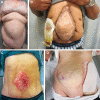An Algorithmic Approach to Perineal Reconstruction
- PMID: 32537311
- PMCID: PMC7288874
- DOI: 10.1097/GOX.0000000000002572
An Algorithmic Approach to Perineal Reconstruction
Abstract
Perineal wounds are one of the more challenging plastic surgical defects to reconstruct. Resections in the perineum vary in size and are frequently complicated by radiation, chemotherapy, and contamination. Furthermore, the awkward location and potential need to maintain function of the anus, urethra, and vagina and to allow comfortable sitting all contribute to the complexity of these reconstructions. In light of this complex nature, many options are available for flap coverage. In this paper, we discuss the properties of perineal defects that make each option appropriate.
Copyright © 2019 The Authors. Published by Wolters Kluwer Health, Inc. on behalf of The American Society of Plastic Surgeons.
Conflict of interest statement
Disclosure: The authors have no financial interest to declare in relation to the content of this article.
Figures











References
-
- Sunesen KG, Buntzen S, Tei T, et al. Perineal healing and survival after anal cancer salvage surgery: 10-year experience with primary perineal reconstruction using the vertical rectus abdominis myocutaneous (VRAM) flap. Ann Surg Oncol. 2009;16:68–77. - PubMed
-
- Küntscher MV, Mansouri S, Noack N, et al. Versatility of vertical rectus abdominis musculocutaneous flaps. Microsurgery. 2006;26:363–369. - PubMed
-
- Feiner B, Jelovsek JE, Maher C. Efficacy and safety of transvaginal mesh kits in the treatment of prolapse of the vaginal apex: a systematic review. Bjog. 2009;116:15–24. - PubMed
-
- Singh M, Kinsley S, Huang A, et al. Gracilis flap reconstruction of the perineum: an outcomes analysis. J Am Coll Surg. 2016;223:602–610. - PubMed
-
- Christian CK, Kwaan MR, Betensky RA, et al. Risk factors for perineal wound complications following abdominoperineal resection. Dis Colon Rectum. 2005;48:43–48. - PubMed
LinkOut - more resources
Full Text Sources
